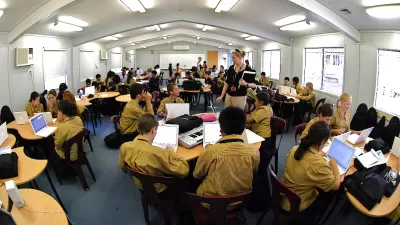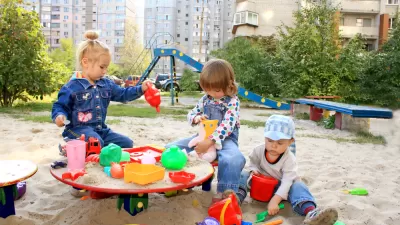A new study out of England provides the first "holistic assessment" linking school design to learning rates. "[S]chool layouts can influence a child’s development by as much as 25 percent over the course of an academic year," reports Ian Steadman.

In a recent post, we explored the debate over whether schools should be designed differently to prevent violence. And a few months ago, we looked at the UK Department for Education's ban on curved walls, glazed walls, internal partitions, and a host of other design elements in order to keep a lid on costs. A new study out of England should be added to the debate when calculating the tradeoffs incurred when schools are designed for any ends not focused of learning.
The results of a study conducted by University of Salford’s School of the Built Environment and architecture firm Nightingale Associates, published in Building and the Environment, "revealed that the architecture and design of classrooms has a significant role to play in influencing academic performance. Six of the environmental factors — colour, choice, connection, complexity, flexibility and light — were clearly correlated with grade scores," writes Steadman.
"Architect Peter Barrett, the study’s lead author, said: 'This is the first time a holistic assessment has been made that successfully links the overall impact directly to learning rates in schools. The impact identified is in fact greater than we imagined.' According to the results, once the differences between the 'worst' and 'best' designed classrooms looked at in the study were taken into account, it was found the be the equivalent to the progress a typical pupil would be expected to make over a year."
FULL STORY: School Design May Affect a Child’s Grades

Manufactured Crisis: Losing the Nation’s Largest Source of Unsubsidized Affordable Housing
Manufactured housing communities have long been an affordable housing option for millions of people living in the U.S., but that affordability is disappearing rapidly. How did we get here?

Americans May Be Stuck — But Why?
Americans are moving a lot less than they once did, and that is a problem. While Yoni Applebaum, in his highly-publicized article Stuck, gets the reasons badly wrong, it's still important to ask: why are we moving so much less than before?

Using Old Oil and Gas Wells for Green Energy Storage
Penn State researchers have found that repurposing abandoned oil and gas wells for geothermal-assisted compressed-air energy storage can boost efficiency, reduce environmental risks, and support clean energy and job transitions.

Poorest NYC Neighborhoods Pay Price for Delivery Boom
The rise of ‘last-mile’ e-commerce warehouses — and their attendant truck traffic and air pollution — is disproportionately impacting the most historically disadvantaged parts of the city.

Greening Oakland’s School Grounds
With help from community partners like the Trust for Public Land, Oakland Unified School District is turning barren, asphalt-covered schoolyards into vibrant, green spaces that support outdoor learning, play, and student well-being.

California Governor Suspends CEQA Reviews for Utilities in Fire Areas
Utility restoration efforts in areas affected by the January wildfires in Los Angeles will be exempt from environmental regulations to speed up the rebuilding of essential infrastructure.
Urban Design for Planners 1: Software Tools
This six-course series explores essential urban design concepts using open source software and equips planners with the tools they need to participate fully in the urban design process.
Planning for Universal Design
Learn the tools for implementing Universal Design in planning regulations.
Heyer Gruel & Associates PA
City of Moreno Valley
Institute for Housing and Urban Development Studies (IHS)
City of Grandview
Harvard GSD Executive Education
Salt Lake City
NYU Wagner Graduate School of Public Service
City of Cambridge, Maryland





























